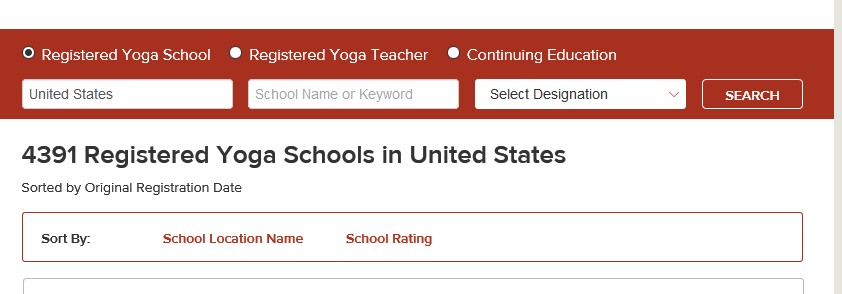

Here we introduce the subjects of registry and certification, common misperceptions about Yoga Alliance, and what exactly the Yoga Alliance registry does and does not recognize.
The following are key points from the more detailed sections to follow. To verify or dig deeper, keep reading. You may also use the contents to jump to the section you’re most interested in.
Q: Am I required to register with Yoga Alliance?
No.
Q: Should I register with Yoga Alliance?
It’s your choice.
Q: I heard that I had to be registered with YA to get insurance. Isn’t that right?
YA registration is not required to get teaching insurance. See a list of insurance providers here.
Q: I applied to work for a studio that requires YA registration as a condition for hire. What can I do?
You can, of course, choose to register with Yoga Alliance. Whether or not you register, you may wish to show this information to the hiring manager, highlighting the information you find most relevant.
Q: Yoga Alliance is not perfect, but they serve an important purpose. Yoga is not regulated in the US. If it were to become regulated like massage and acupuncture, you would see a huge increase in fees. YA is an entity that shows that instructors have a standard of training to protect their students. If it weren’t for them, yoga would already be regulated by the government which would increase fees and barriers to entry.
That’s what you’ve been led to believe, but unfortunately it’s wrong. Yoga Alliance actually does not fulfill the “important purpose” of providing a “standard of training to protect students.”
Presumably all teachers and trainers would agree with you that they do not want to be government-regulated. People in any occupational field tend to prefer self-regulation. Nonprofits are usually created to help with the task of self-regulation.
Regulation refers to an attempt to prevent people from holding a title without proving a predetermined level of skill and precaution. From a legal perspective, regulated occupations are those controlled by a governmental regulatory body. For example, professions such as nursing and skilled trades such as plumbing are regulated industries in some nations. In effect, these occupation titles are put into a reserved status, and the law requires a certificate, license, or registration obtained from a body overseen by the government. (See also: The Canadian Information Centre for International Credentials)
In contrast, people within many occupations voluntarily “self-regulate.” The intention is often to ensure a basic standard of competency. Sometimes, the efforts are to validate greater-than-average or specialized skills. Such self-regulation often takes the form of nonprofit organizations that are said to represent those in a particular occupation and that is responsible for registering, accrediting or certifying individuals according to whatever criteria they determine.
Typically there are multiple organizations fulfilling such a role within a single field. For example, U.S. universities and colleges may be accredited by regional organizations or by national ones, and they may be institutionally accredited or programmatically accredited by various organizations.
Yoga Alliance does not help yoga teachers and trainers to self-regulate because it does not propose, measure or enforce standards (and this did not change with their new requirements in 2020).
The efforts by yoga teachers and trainers to self-regulate has at least two problems:
1) The misperception that the big job of self-regulation is being taken care of by Yoga Alliance when in fact it it not.
2) The “200-hour” model popularized by Yoga Alliance and its “approval” of “trainers” based only on paperwork and fees, resulting in a commercialization of teacher trainings and a glut of unprepared teachers.
Q: How can we keep yoga safe and also allow freedom?
That is arguably the fundamental challenge that we as a yoga collective face.
Everyone can choose their own approach to this subject. Yoga Teacher Central takes the position that:
- The only wise and sustainable model for virtually anything is self-responsibility as opposed to policing by an outside authority.
- Real and true improvement is more likely to be successful with information, support and empowerment as opposed to bureaucracy.
- Thus, the facts highlighted here are not meant to imply advocacy for outside or industry-wide governance. Rather, this is an effort to widely inform yoga teachers that there is a common misperception that governance and standards-enforcement exists when it most definitely does not. With our eyes open to the facts, we are better prepared to approach the subjects of standards and improving industry-wide teaching competency.
Q: Why are you making a big deal about this? You don’t have to join.
Many teachers have used the fact that everyone has the freedom to NOT join Yoga Alliance as reason to stay quiet about YA alternatives and competency standards. Staying quiet remains an option.
However, this means the yoga teaching field and the public continue to live with these widespread misperceptions:
- Misperception #1 – There is verifiable reasoning for the designation of 200 hours as a model for trainings, when in fact no explanation was ever given for an hours-based training, nor for 200 hours in particular.
- Misperception #2 – Teaching competency standards have been set and are enforced when neither is true.
By facing this truth, we are more likely to realize we have an opportunity to work with others to create options more closely aligned with true training excellence and teaching skill.
Q: Why do you care?
Some may be curious why we are publishing so much information on this topic. I’m the founder of Yoga Teacher Central and I personally haven’t been a member of Yoga Alliance since my first experience with them as a new teacher around 2009. It was then that I learned that they don’t oversee or enforce standards with the schools they “approve.” They didn’t even have a way to take simple feedback on my experience with one of “their” schools.
From that point forward, I didn’t engage in any conversations about Yoga Alliance as it was clear to me that they were irrelevant to my work of providing teaching and training resources.
On a side-note, my sense is that the organization was originally founded by wonderful people. But I understand that when an organization continues in name only, disconnected from the humans who founded it, it morphs into a non-human entity — as with corporations. Despite incredible amounts of money always being spent by organizations to make themselves appear to be human, organizations that are disconnected from their founders are non-human entities. Entities have as their primary objective to sustain themselves. Humans come and go, secondary to the system which no longer has the accountability its human founders once did. Even when we think the organization is “run” by the “heads” or “faces” we are shown, the people are always secondary to the entity itself. In 2018, J. Brown wrote:
“The charismatic CEO of the Yoga Alliance, David Lipsius, hired to overhaul the failed industry standards for yoga teacher training just over a year ago, has departed his position right at the very moment his master plan is set to be implemented. Lipsius’ unexpected farewell aside, the proverbial writing has surreptitiously appeared on the wall: The organization is planning to assert new power, but whose interests are being served is not clear.” – J.Brown, Nov 29, 2018 link
So although I have no personal interest in Yoga Alliance, in 2019, I was inundated by requests from trainers who were reacting to the news of the upcoming YA change in requirements. They shared information, experiences and issues that I felt should be widely known. These resource pages are my effort to bring that information to light and to support those who are making efforts to evolve the field in a positive way.
Q: What is YA doing with all that money?
I found it quite gut-wrenching to actually do the math (see below) and become aware of how much money has been siphoned out of yoga teachers’ pockets. It makes me sad, as we all know how, often, people have to sacrifice quite a lot to pursue their calling to teach yoga.
How YA has used the money it has received from teachers and trainers is a point we can only speculate about. Yoga Alliance states that it is a “nonprofit association representing the yoga community” so it would be reasonable for registered teachers and trainers to ask for an accounting of the funds received. For some ballpark figures of costs to run the registry, see below.

Yoga Alliance does not certify yoga teachers nor does it provide accreditation of trainers or training schools. Yoga Alliance is a registration service.
Prior to availability of the Internet, registries provided lists that people needed because their phone books only had phone numbers and addresses for contacts located in their local geography. Registries gave them access to contacts they couldn’t easily obtain any other way.
With the advent of the Internet, any organization or individual can of course be accessed directly. Now, registries have lost the value they once held. In order for a list to be valued above free, presumably it would provide something more useful than contact information and confirmation of fees paid.
That being said, a Yoga Alliance certificate is absolutely not necessary to teach yoga. It’s the norm, yes, and it has a lot of big marketing money behind it. But an RYT certificate does not automatically mean that you are knowledgeable, that you are reliable, or that you are trustworthy. Nor does it mean that your selected training program is any of those things, either. While many commercial yoga studios will prefer yoga instructors who are certified with the Yoga Alliance, not all do, especially not those who are more interested in the ancient yogic philosophies and traditional practices. – Brett Larkin, What is Yoga Alliance and Do I Need an RYT Certificate to Teach Yoga? link
There is No Accreditation for Yoga
No one really wants to admit there is no accreditation for Yoga. Anyone who claims to be “approved,” “certified” or “licensed” by the YA is either grossly uninformed or disingenuous… In filling out the paperwork and paying the fees, yoga teachers and training programs purport to follow a vague set of curriculum guidelines … The registry amounts to a digital rubber stamp or paid advertising. Not to mention, the YA does not disclose what they do with the money they collect from the Yoga community. Even if everyone is being true to their word, referring to the YA guidelines as “standards” is quite a stretch. – J. Brown link
The following screenshots are from the Yoga Alliance web site, September, 2019.
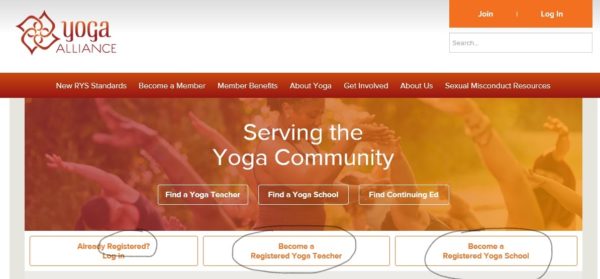
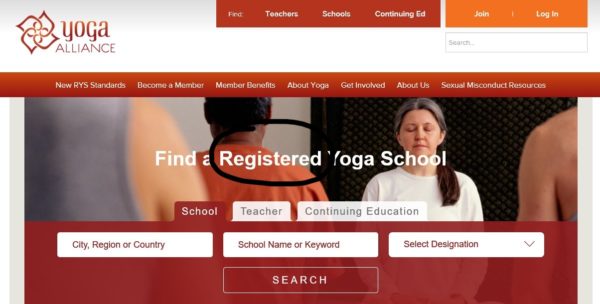
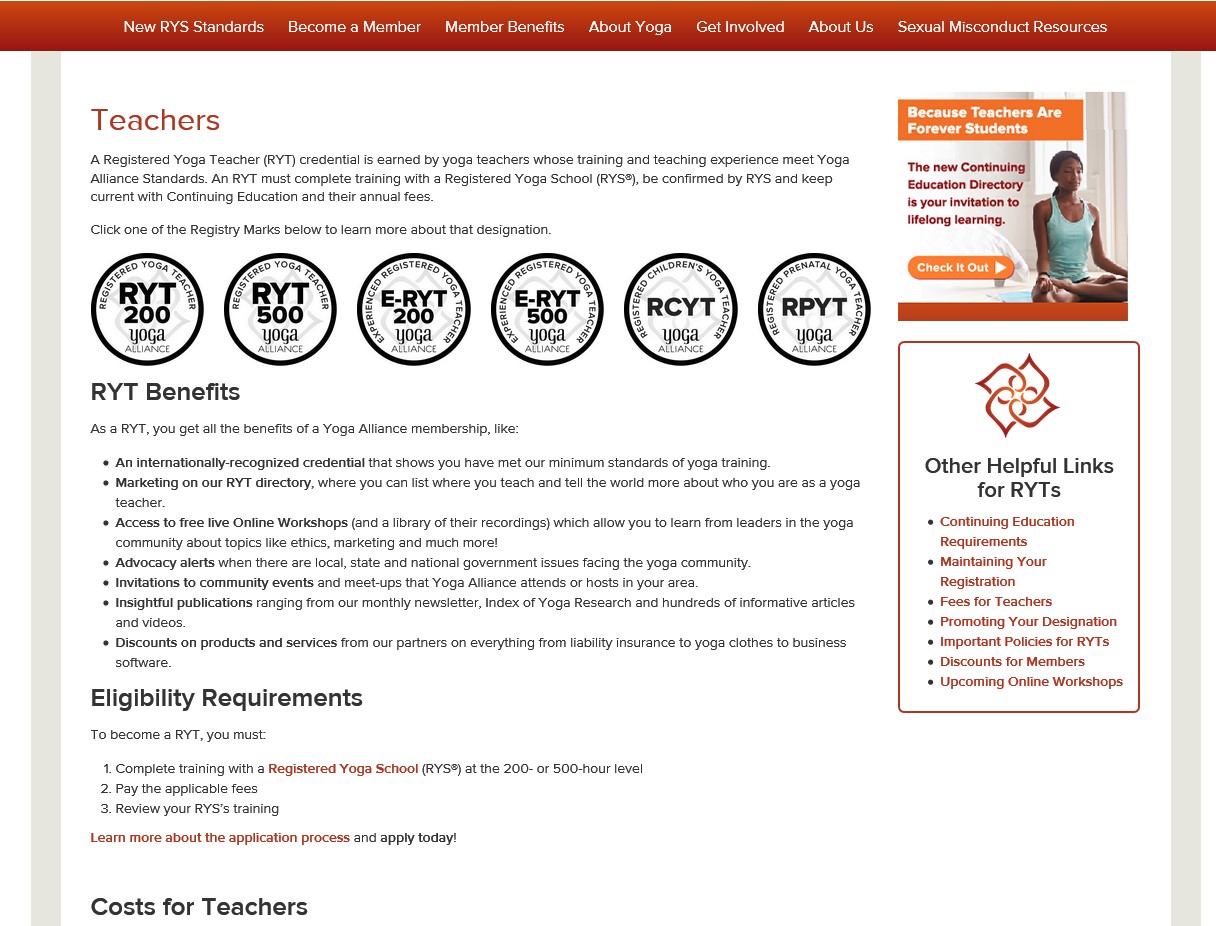
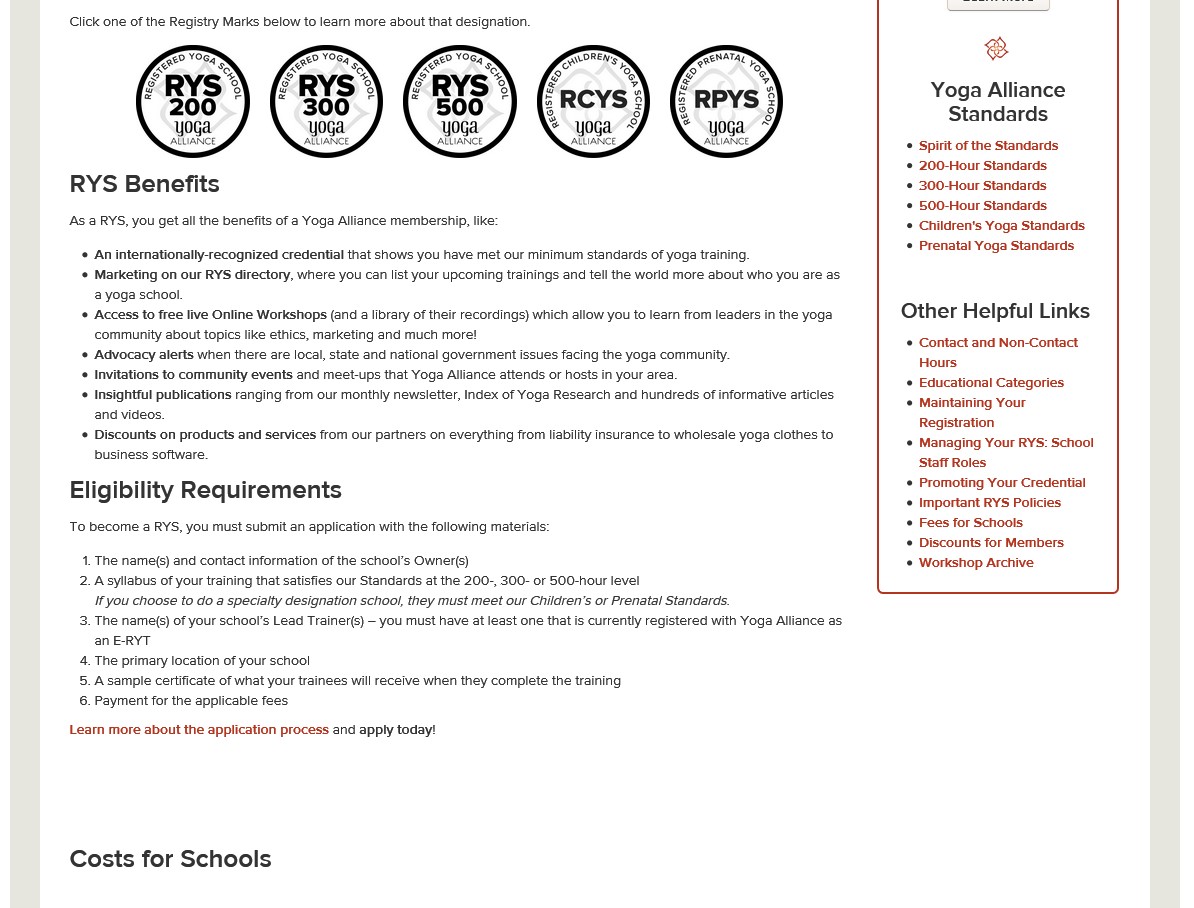

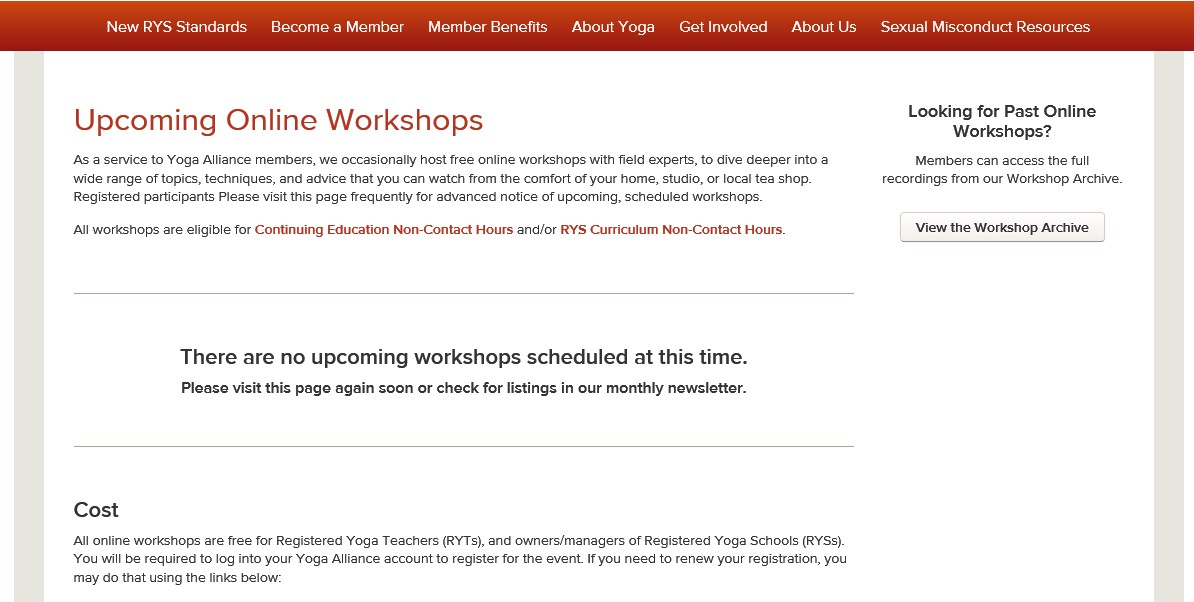

The level of competency that an individual yoga teacher achieves after a training is the responsibility of the trainer and the trainee only. There are no minimum competency standards specified or upheld by Yoga Alliance or any other industry-wide organization.
The certificate the school issues is the only valid credential… the relationship between a teacher holding a certificate and their students is what validates the effectiveness of the school. – Brandon Hartsell and Leslie Kaminoff, Yoga Alliance Behind the Curtain link
Go deeper here: Who is Responsible for Teaching Competency?

Hours-Based Certification is a Charade
One of the unintended consequences of the migration to online yoga education is that hours-based certification has been exposed for the charade that it always has been. Anyone who has assumed the role of yoga teacher trainer likely knows the extent to which the number of hours a person spends in physical attendance is not necessarily any indication of understanding or competency. It is undeniable that there is a wide range of factors that play into where someone is in relation to yoga, and their ability to teach it effectively, that have nothing to do with fulfilling arbitrary time requirements. – J. Brown, Yoga Training, Teacher Revival, Nov 23, 2022 link
It’s a verifiable fact that being on the Yoga Alliance registry has no relationship to teaching competency and that teacher and trainer insurance may be obtained without Yoga Alliance (or any other) registration. Many widely recognized and influential teachers (and less well known teachers as well) are NOT registered with YA.
However, misperceptions appear to be widespread:
The reasons for these misperceptions can only be speculated about and likely include:
Yoga Australia uses a model that better addresses these issues. Learn more here: Yoga Alliance Alternatives.
YA Burdens Reduce Trainer Productivity
I’ve been teaching yoga since 1998 and training teachers since 2005. I’m finding that at best, YA has become a distraction to my training programs. The hours that I am spending figuring out how to shift my 200 hour curriculum — which was already above the YA “standards” — to fit their mold and then to enter my 300 hour curriculum into their system, which will be changing soon too, are hours that I should be teaching, training, and continuing my research and practice. – Teacher Trainer
Ethical & Other Considerations
After fifteen years of affiliation with Yoga Alliance, I have decided to revoke my registration. I will no longer be individually associated with Yoga Alliance as an RYT yoga instructor nor will I register any further yoga schools with Yoga Alliance. I will continue to teach workshops, immersions, retreats, and courses. They simply will not be associated with Yoga Alliance. I will also no longer call my immersions “Teacher Trainings.” There are several reasons for this decision. I encourage other yoga instructors to read this and consider the best way forward for themselves and for the practice of yoga. – Josh Schrei link
Please see the original post by Josh Schrei for much more. He proposes and expands on these points:

The common misperceptions described above prompt some considerations:
Each teacher and trainer may choose their own approach to this subject. Yoga Teacher Central takes the position that:

To apply for the YA registry in 2019, trainers are required to pay $640 and submit an extensive application. The fee includes an unusually high application fee.
Teachers have shared stories with Yoga Teacher Central (supported by documentation) showing that Yoga Alliance has declined applications while keeping the $400 submitted by teachers.
This screen shot was taken Mar 1, 2024 on Guidestar, a site for searching nonprofits. Yoga Alliance, a nonprofit, has $31 million in assets taken off the backs of yoga teachers, who notoriously struggle to get by financially.

In September 2019, Yoga Alliance had 7,748 registered yoga schools.
Yoga Alliance has 86,928 registered yoga teachers.
The only way to answer the question of how this money is used is to ask Yoga Alliance to share that information. Otherwise, we are only speculating.
Meanwhile, we can consider a few general, ballpark figures to help get some perspective. I (Shelly) have worked at small, medium and large sized firms whose primary service was software and communications, and I’ve been running an online business with specialized software since 2012. So I can provide a few general ballpark figures.
I don’t know if YA has office space, but no office space is needed which is great, because office space is a big expense. In these types of operations, the greatest investment is typically software development to create the business infrastructure.
An organization’s tech expenses are broken down into infrastructure development and maintenance.
Beyond tech expenses, there are the typical expenses of marketing and salaries for administrative personnel.
So at the high end, we’ve got $150k in tech expenses + $100k in marketing + $300k in salaries for a grand total of $550,000. Even if we practically doubled this already generous allocation we’d only get to a $1 million budget.
Receiving payments online incurs a fee from the financial processor of around 3% so $7.5 million in fees would be $7,250,000 received.
Expenses of $550,000 is less than 10% of the annual money received, plus YA has the additional pot of $7.5 million in application fees.
Where has the $14 million dollars plus $7 million per year gone? Only Yoga Alliance could answer that question and registered members may wish to discuss their priorities for usage of the funds with YA.
The following screenshots are from the Yoga Alliance web site search results for registered yoga schools and teachers, September 27th, 2019.

